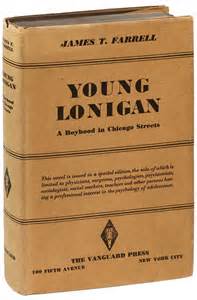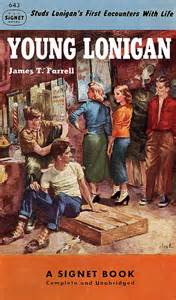It was just a well, because he wanted to slip around to the can and have a smoke before he joined the folks out in front to be told he looked so swell and all that boushwah. Inside the damp boys’ lavatory on the Indiana Avenue side of the building, he leaned against a sink and puffed away, absorbed in the ascending strands of smoke. He wondered if it was really a sin to smoke, and told himself that was all bunk. (35–36)
It is time to take on Studs Lonigan. Studs Lonigan, one of the important figures in Great Depression-era literature, was the creation of 28-year-old James T. Farrell. Farrell was from a working class Irish immigrant family in Chicago. He has this in common with his most well-known literary creation. I cannot say for sure how much of what happened in these novels is autobiographical, but it seems likely that much of it was drawn from life. Studs was born around the same time Farrell was. They both attended Catholic grade school and liked to play baseball. While Farrell lives a long life as a productive writer, Studs dies young and worn out from a squandered life. As with Frank Norris, we are not given a simple morality tale. Like Norris’ Vandover, Studs is a product of his culture and environment. We can blame both for individual bad choices, but we would be misreading these texts to avoid appreciating the role of fate. Farrell clearly appreciated Norris, who is quoted at the beginning of the first novel about Studs Young Lonigan. (“A literature that cannot be vulgarized is no literature at all and will perish.”) Perhaps Studs Lonigan reflects this vulgarization of naturalism.
Studs Lonigan’s life is told over the course of three novels, written between 1929 and 1934, and published between 1932 and 1935. They probably should be read together. Farrell has already seen the novels published as a single trilogy in 1935. I can imagine Studs becoming a kind of nostalgic working class figure for the Great Depression generation, even as it works as a warning against self-aggrandizement and reckless squandering of potential. I would want to read both at the same time. Studs’ more attractive and heroic moments (even if they are few) suggest the idealization of the working class experience, so common in New Deal-era literature. The metanarrative, of improper self-confidence and wasted potential is actually the story of the entire nation.
The story of Young Lonigan covers around one year in the life of Studs Lonigan. It begins with his imminent graduation, at the age of fourteen, from a Catholic grade school in Chicago. He begins to plan to attend high school but has no clear idea of what he wants to do. (Of course, his mother wants him to prepare for the priesthood.) Instead of going back to school, he just sort of drifts into a new group of friends who spend much of their time just hanging out, smoking, drinking, and fooling around with girls. This boredom leads to episodes of ethnic and racial violence and antagonism. The climax of the novel involves Studs’ participation in anti-Semitic intimidation. By the end of the novel, Studs has moved to the wrong side of the tracks.
Young Lonigan is also a story of generational conflict, education, and the struggle between the individual and the institution. Since these themes are all combined, I want to discuss it as a single unit and suggest it as a way to approach the text from a libertarian perspective. To start with, Studs’ parents have hopes for him, but are aware that their own life does not present much of a good model for them. For this reason, they entrust the local Catholic schools to set Studs on the right path. Education is clearly presented here a moral corrective much more than as a cultivator of autonomy and critical thinking. “Old Man Lonigan” himself was familiar with the streets but in his older age sees it as a warning and the reason for educating Studs through the church.
And the old gang. They were scattered now, to the very ends of the earth. Many of them were dead, like poor Paddy McCoy, Lord have mercy on his soul, whose ashes rested in a drunkard’s grave at Potter’s Field. Well, they were a find gang, and many’s the good man they drank under the table, but . . . well, most of then didn’t turn out so well. (16)
We quickly learn what a waste the investment in education was, if the goal was to set Studs to the correct moral path. One suspects that the teachers know this was well as anyone, which is why the priest devotes his graduation speech to a final plea to the students to evade Satan’s clutches. (If Catholic education worked as a moral correction, we suspect this would not be necessary.) If anything, the children learned to have only contempt for their teachers. Much of their education seems to involve learning how to evade the regulations of the school. Smoking seems to become one way that these young men express their independence from the lessons they were taught in school.
Another tension between the individual and the institution is seen in how central the community is to the thought of Studs’ parents. They are clearly very concerned with how the neighbors look on their son, his actions, and what he becomes. At a more vulgar level, they seemed to care that neighbors might think they were cheap if they did not send Studs’ to high school. Education for the Lonigan’s is almost completely detached from utility and is mostly about image.
We should not be surprised that Studs choses the streets over the schoolhouse. This is, in fact, the more practical and natural path. Indeed, this may be a general problem in mass education. It has never been explained to me why everyone is better off going to school. It seems each career and each regional context would have its own educational needs. For some, the street provides a more useful education than does the schoolroom. Studs’ choice to abandon his education for a rather unfortunate circle of friends is not strictly speaking irrational. It was rather the practical choice, given his choices as a working class, second-generation immigrant, youth. Yet, while it may have been the moral practical and natural of the two choices, we need to ask why Studs was given only two choices. I am not calling for massive dropouts of students, but questioning why the choice we give many working class urban youth is between the street and boring, irrelevant classrooms.
We learn just how tragic this limited choice was by the end of the novel. Studs’ education does not really end when he commits to the street. One thing he learns is racism, which he takes up by the end of the novel. We are not sure how much he really likes picking on local black and Jewish youth. He is likely parroting what his peers do and say. But how is that different from the classroom?


